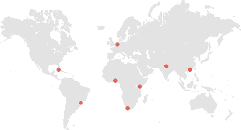Cape Town may seem like an unusual participant in a research program focusing on New Towns. However, the city has been home to many colonial settlements, ever since the Portuguese, the Dutch and the Spanish started sailing towards the Indies in the 15th Century. Nowadays, the city is planning to expand the city by building the New Town Wescape, 25km from Cape Town to the north, far beyond the urban edge.
The city’s urban strategy leaves room for doubts. Is building a New Town a good solution to the need for housing in Cape Town, a city which already suffers from extensive urban sprawl? With almost 4 million residents, Cape Town is the second-largest city in South Africa and one of the most multi-cultural and fragmented cities in the world: a patchwork of disconnected business districts, affluent gated communities and poor townships (like Lotus Park), spread out across an area far beyond the city bowl defined by the bay and Table Mountain.
This urban fragmentation concerns not only spatial barriers, but also social, political and administrative barriers, as well as barriers of the imagination which reveals in every level of urban planning. Divisions between departments, levels of government, and political affiliations, frustrate collaboration, effective decision-making and policy execution.
Origins of this fragmentation lies with a combination of the legacy of Apartheid spatial policy, the middle-class ideal of single family homes on individual plots of land, and politicians allowing developers to choose the way of least resistance for expansion of the city. Planning and physical interventions were instruments to manage racial segregation during the Apartheid period and continued until 1990. Even after ANC (African National Congress) took over and a policy of urban redistribution was started, the modernist blueprint planning has proven to be persistent. Recently, the economic growth of South Africa has caused a rise of the middle classes, with new urban questions arising.
The Density Syndicate
An alternative urban strategy for Cape Town could be to increase the density of the existing urban fabric, thereby improving access to economy and services for the residents of Cape Town. Densification can also be a means to combat the social segregation defining the city structure. INTI formulated this alternative strategy as the Density Syndicate, which started in May 2014 as a Research-by-Design project, using the capacity of design proposals to investigate and discuss potential development strategies. In collaboration with the African Centre for Cities (ACC) and the Cape Town Urban Planning Department, INTI worked on possible densification schemes in the Density Syndicate.
Three locations were chosen to speculatively test the possibilities of density strategies in the very different, yet exemplary contexts of a greenfield site (TRUP++), a brownfield site (Maitland) and an informal settlement (Lotus Park). Each site offers a unique set of parameters and contested interests. By using the combined design intelligence of Dutch, German, Turkish, American and South African designers and urbanists, the Density Syndicate developed innovative, alternative strategies for the future of Cape Town. Three teams developed speculative designs for densification in each of the areas, supported by a reference group including representatives from the City of Cape Town, an economist, a social scientist, an historian, an ecologist and relevant design thinkers. Additionally each team worked with Masters students from the University of Cape Town.
Results
The results were presented at the ACC-organized exhibition ‘City Desired’ at City Hall in Cape Town (November 2014); at the exhibition ‘Department of Design’ (part of World Design Capital Cape Town 2014), the Conference ‘Density and Access’, published in the book ‘Cape Town. Densification to cure a segregated city’ and presented at the OP-UP church on the Black River, a schoolyard enclosed by conference ‘Urban Africa’. New strategies for the world’s fastest urbanizing continent’ in Rotterdam at Het Nieuwe Instituut (April 2015).







